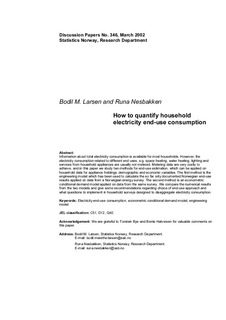| dc.contributor.author | Larsen, Bodil Merethe | |
| dc.contributor.author | Nesbakken, Runa | |
| dc.date.accessioned | 2011-11-26T11:47:08Z | |
| dc.date.available | 2011-11-26T11:47:08Z | |
| dc.date.issued | 2003 | |
| dc.identifier.issn | 1892-753x | |
| dc.identifier.uri | http://hdl.handle.net/11250/180487 | |
| dc.description.abstract | Abstract:
Information about total electricity consumption is available for most households. However, the electricity consumption related to different end uses, e.g. space heating, water heating, lighting and services from household appliances are usually not metered. Metering data are very costly to achieve, and in this paper we study two methods for end-use estimation, which can be applied on household data for appliance holdings, demographic and economic variables. The first method is the engineering model which has been used to calculate the so far only documented Norwegian end-use results applied on data from a Norwegian energy survey. The second method is an econometric conditional demand model applied on data from the same survey. We compare the numerical results from the two models and give some recommendations regarding choice of end-use approach and what questions to implement in household surveys designed to disaggregate electricity consumption.
Keywords: Electricity end-use consumption, econometric conditional demand model, engineering model. | no_NO |
| dc.language.iso | eng | no_NO |
| dc.publisher | Statistics Norway, Research Department | no_NO |
| dc.relation.ispartofseries | Discussion Papers;No. 346 | |
| dc.subject | Household consumption | no_NO |
| dc.subject | Electricity consumption | no_NO |
| dc.subject | Engineering model | no_NO |
| dc.subject | Norwegian energy survey | no_NO |
| dc.subject | JEL classification: C51 | no_NO |
| dc.subject | JEL classification: D12 | no_NO |
| dc.subject | JEL classification: Q40 | no_NO |
| dc.title | How to quantify household electricity end-use consumption | no_NO |
| dc.type | Working paper | no_NO |
| dc.subject.nsi | VDP::Social science: 200::Economics: 210::Economics: 212 | no_NO |
| dc.source.pagenumber | 28 s. | no_NO |
